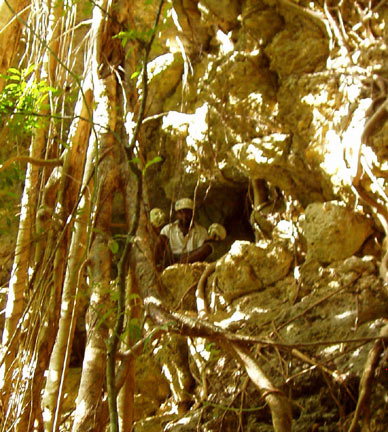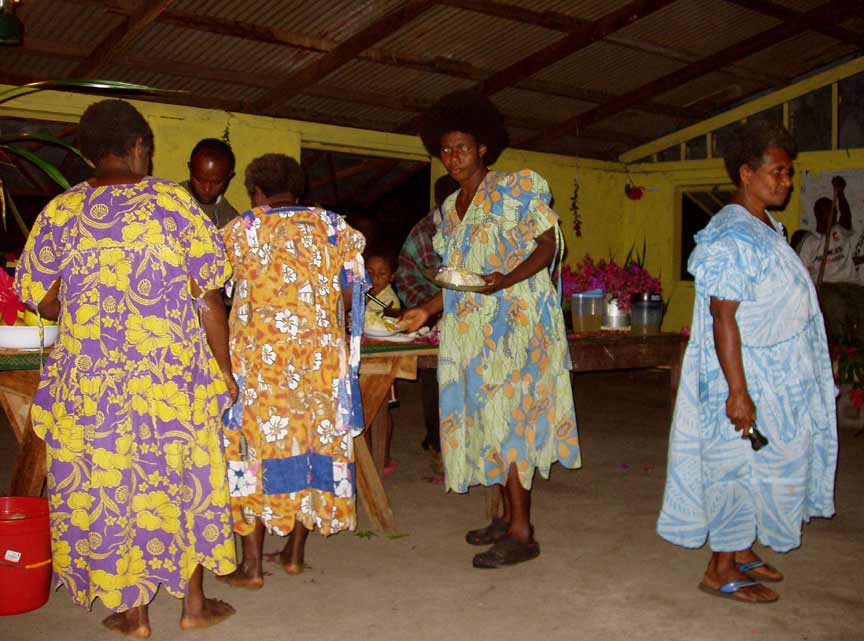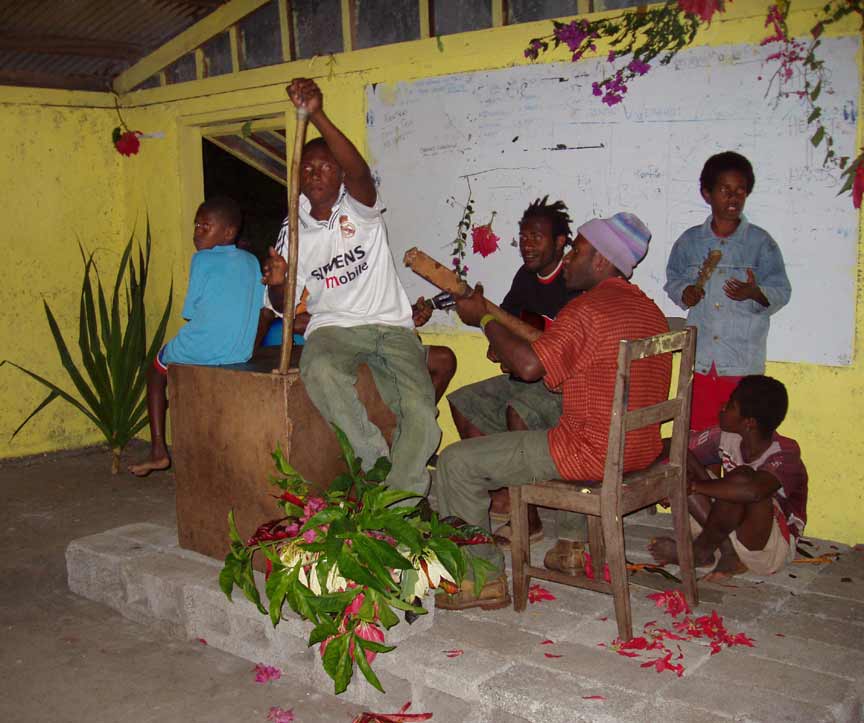Dillon's Bay, Erromango Island, Vanuatu - with pictures

Harmonie
Don and Anne Myers
Fri 25 Jul 2008 01:52
|
18:49.385S 169:00.676E
Note: This version has pictures
attached.
On Thursday, 7/10, we left the bouncy bay of Port
Resolution, the villagers, the yachtless yacht club, the huts, the naked
dancing, Mount Yassur volcano and the island of Tanna behind and
sailed the fifty or so miles northwest to the island of Erromango and Dillon's
Bay. The wind was still somewhat ferocious, making the motor slog into the
wind, out of Port Resolution Bay and between the nasty reefs a bit of a
challenge. Graptolite was ahead of us as we left the bay and
watching them power up the waves and crash down the other
side was almost worse than experiencing the bumpy ride ourselves.
Once we cleared the reefs, we turned downwind and had a fast sail to Erromango
Island. Dillon's Bay is on the west side of Erromango, so as soon as we
hit the lee side of the island, the southeasterly wind and waves calmed down a
bit and the remainder of the sail into Dillon's Bay was quite lovely. We
arrived just past dark to find about eight other rally boats quietly anchored in
the peaceful and - finally! - flat bay. James on Cleone helped to
guide us to an appropriate anchoring spot via the radio and we settled down
for our first restful night since leaving Fiji four days
earlier.
A few notes on Erromango. First of all, the
name. Erromango is pidgin English for 'here are mangos'. Apparently
there are quite a few mango trees on Erromango. The same is true, or was
true, for sandalwood trees. According to the guidebooks, all the
accessible sandalwood trees on Erromango were harvested and taken away
by Europeans (Peter Dillon was the first - hence the name Dillon's
Bay) over the course of a short forty-three years (1825 - 1868).
Not only was the sandalwood tree population on Erromango
decimated by outsiders, but the diseases brought by the traders, missionaries
and blackbirders (blackbirders took villagers against their will to Fiji
and New Caledonia as indentured servants to work in the sugarcane or mining
industries) also wiped out an estimated 95% of Erromango's population in the
1800's. Unbelievable.
The islands of Vanuatu in general were populated by
small clans that fought their neighboring clans on a regular basis.
Cannibalism was quite common. The belief was that if the men ate the flesh
of their enemies, their status would increase, as would their power
and their defense against evil spirits and sorcery. Today the
people in neighboring villages no longer fight each other (or eat each other),
but we have noticed that the people we've met along the way do not seem to
travel from village to village, let alone from island to island.
They appear to lead a very isolated existence with the outside world only
coming to them in the form of visiting boaters like us, the occasional
government employee, and of course, the missionaries. It's no wonder they
always seem happy to see us.
Ok, back to Dillon's Bay. The next day, some
of the other rally boats (Quasar, Cleone) had arranged for a guide to take us to
some of the caves Erromango is known for. Early that afternoon, we hopped
in our dinghy and headed to shore where we were told the guide would meet
us. As we approached the shore, a group of little kids came running,
waving to us like crazy and yelling. We dinghied up the little stream that
empties into the bay and the little guys held our dinghy in place while we
hopped out and then they helped us tie the dinghy off on a nearby
tree. Not a word was said aside from 'Hallo', and when we scrambled up the
stream bank onto dry land, they just scampered around while we searched out our
guide, Thomas.
Thomas was found and he and his two nephews, Edward
and Manua, joined us in our dinghy and we headed off in a dinghy parade with
Quasar, Kasuje and Cleone along the shore of the big bay to where
the caves were. Along the way Thomas pointed out the pieces of beach land
that he owned and directed us to one of them where we left the dinghies. A
short five-minute walk through the forest later, and we were at the foot of two
small caves - one that required crawling into and one that required crawling up
to. Once again we didn't really know what we were in for. We were
thinking we were just going to wander through a few caves - maybe see some
stalactites and mites. Not so. At some point we are really going to
have to stop being such clueless tourists and actually pay more attention to
where we are going. The group split into two and Thomas took Don and I up
to the cave that required crawling up to. We crawled up, Thomas acting as
our human safety railing, and stepped into the small hillside cave.
Whoa! Dead people! I almost stepped on an entire pile of bones and
skulls. Definitely human bones and skulls. Thomas smiled at our
surprise. 'Pick them up for a picture!' Thomas encouraged us. I
don't think so....wouldn't that disturb the spirits and cause us bad luck for
seven years or something? We didn't touch the bone pile and did our best
to keep from stepping on it in such a small space (picture 1). Thomas
told us that the people of Erromango used to live in the caves (there are many
of them throughout the island), and when someone died they were not buried,
instead they were laid to rest in an unoccupied (at least by living people)
cave. So basically we were touring burial caves. We felt badly for
the skeletons...there was no semblance of order and they were simply
jumbled in a pile with their skulls lined up. After we crawled back down
to safety, Thomas posed with the skulls for us since we were too skittish to
pick them up ourselves (picture 2).
Next we were led by Edward down into the second
cave. Yup, more bones. Widely scattered this time making it almost
impossible not to tread on some in the cave's darkness. Picture 3 shows
Edward standing next to the second cave that we crawled down into.
On the way back to the village to drop Thomas and
his nephews off, Thomas asked what kind of jobs we had back in America.
When Don told him we were engineers, Thomas was quiet for a minute, and then
timidly asked if we knew anything about generators. Don said he was
more a mechanical guy than electrical, but he would take a look at the
generator. James from Cleone came with us for additional help and we
landed once again amid giggling and staring little kids. Our little kid
entourage tagged along as Thomas took us to a small clearing in the village and
brought the errant generator to Don and James. 'Do you have any
tools?' Don and James asked. 'Yes, I will get it.' answered
Thomas. And get it, he did - a few minutes later he came back
with the one multi-tool that had come with the generator. Hmmm...
Don and James went to work and soon had an audience
of kids and adults that nearly filled the clearing (picture 4). That's
Elizabeth in the red jacket behind Don - or Young Elizabeth as James calls her -
she crews on Cleone. Note the little boy in the blue shirt sitting in the
center of the picture. He really does have arms, he just has them pulled
out of his sleeves. When we were in Tanna we noticed the kids doing the
same thing - constantly pulling their arms out of their t-shirt sleeves. I
asked Thomas about this. 'They do that when they get cold.' Thomas
explained. 'They don't have any jackets or sweaters like you do, so they
pull their arms out of their sleeves to stay warmer.' Oh.
How exactly do you respond to something like that? And it was true.
When we were in Tanna, it was chilly, so most of us had fleeces or jackets
on. The villagers and kids had nothing but their t-shirts. And
the kids almost always had their arms pulled out of their sleeves. After
this exchange with Thomas, I looked more closely at the circle of kids around
us. Many of their clothes were stained, tattered, and some way too
big. This was the first place we had been in all of our travels where we
really felt the people were poor and in need of some help. Don and James
did their part, but in the end after several hours, were not
successful. The generator would run (we filled its empty tank with gas
from our dinghy tank), but it wouldn't generate power. Thomas thanked us
for our help and said it was ok. We all felt badly.
By then it was time for dinner. That morning,
the villagers had offered to put on a feast for us in exchange for a small
donation ($5.00 each). They said the donations would go toward their
school, but we suspect that since they were building a new church (a nice, solid
building standing amongst the rundown huts of the villagers), some of our
donations were going there instead. Several more rally boats had come into
the bay during the afternoon, and the villagers now had a record ten yachts in
their bay - a cause for celebration for sure. We were all invited to the
dinner, which was to be held in their town hall. Donald, who seemed to be
one of the village's leaders, gathered us all together and asked us to wait
outside the town hall until the villagers were ready. The sun quietly set
as we waited and finally, when all the boaters were in attendance and all the
villagers ready, Donald led us to the town hall. The chief greeted as we
stepped inside the big open room, and we were given a flower to place behind our
ear. As we filed in, the villagers assembled on the other side of the
room applauded. Yes, they applauded us as we filed into the town
hall.
Once we were all assembled on a long bench that
lined one side of the room, the chief said a few words of welcome, the food was
blessed, the band struck up a tune (sounding strangely like a polka) and we
were invited to pick up a plate (no palm fronds this time) and choose some
food from the buffet that was set up on a table in the
center. It was difficult to see since the room was lit by only
two oil lamps hanging on either side of the food table. But even if
the light had been better, with the exception of the rice, hard boiled eggs and
the coconut crab, it would have been difficult to identify any of the
food. The Vanuatu people eat a lot of vegetables like yams and tarro (like
a potato) and manioc - so most of the dishes were probably made from the
same. We took a deep breath and piled on as much as we thought we could
politely eat - we certainly didn't want to appear ungrateful and leave
anything on our plates. Thomas had told me earlier that day that the
village was very short on rice since the supply ship hadn't been to Dillon's Bay
in over two months. I thought about this as I scooped some rice on my
plate from one of the three platters of rice that were prepared for
us. The villagers politely waited for us to not only finish eating,
but also do some dancing to the polka-like music before they approached the food
table to get their own meals.
Picture 5 shows some of the village women at the
buffet table in their 'Mother Hubbard' dresses. These flowered muumuus are
everywhere in Vanuatu - all the girls and women we have seen in the villages
and many we've seen in the city of Port Vila wear them.
Definitely brought on by the missionaries since the traditional dress for women
in most of the islands of Vanuatu is a grass skirt and nothing
else.
Picture 6 is the band and their homemade
instruments - a box string base, two guitars and some type of maracas.
Their music wasn't bad and they really seemed to enjoy providing it for
us.
That night after dinner in the village we packed up
the dinghy and prepared for an overnight sail to the Vanuatu capital city
of Port Vila. It was a fast sail in the still brisk winds and waves.
Part-way through my first 3-hour night watch I was wishing we had eaten
something a little more digestible for dinner. All I kept thinking about
were the unidentified lumps of food sitting in my stomach, just waiting for the
right opportunity to make a second appearance. I survived the night,
stomach intact, and we were both glad when we arrived in the calm waters of Port
Vila Bay at nine the next morning. We picked up a mooring right next to
Calle Due (of loss-of-rudder-control fame) and laid low for the rest of the day
and evening.
Over dinner that first night on the boat in Port
Vila, we marveled at how much we had seen and experienced in only three
days in Vanuatu. The ceremonies and dancing in Tanna. The volcano
and feast. The burial caves of Erromango. The people of Dillon's Bay
who were so generous and friendly - putting on a feast and welcoming us with
applause, flowers and their precious rice - all within a day's notice.
People living with basically no electricity, a
little bit of running water, no TV, no radio, still using outrigger canoes dug
out by hand for transport, living in huts, singing, dancing and laughing.
It's a whole different world here in Vanuatu and we feel privileged to be a part
of it for a little while.
Anne
|





